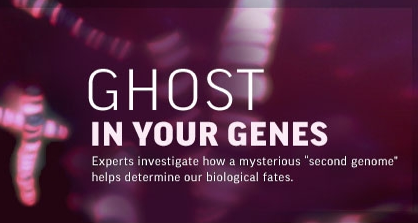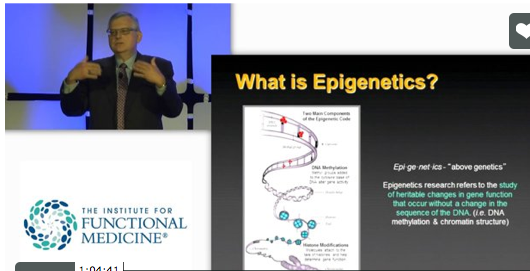Imprinting, Gene Regulation, and Early Development
" If these gametic imprint marks are not established correctly in both the egg and the sperm,
major developmental and behavioral disorders can occur in the offspring."

Randy L. Jirtle, PhD, is a Senior Scientist at the University of Wisconsin-Madison McArdle Laboratory, and Professor of Epigenetics at the Department of
Sport and Exercise Sciences, University of Bedfordshire, Bedford, UK. He was previously professor of
radiation oncology and associate professor of pathology at Duke
University, Durham, NC, where he had been a faculty member since 1977.
He graduated with a B.S. degree in nuclear engineering in 1970 and a
Ph.D. degree in radiation biology in 1976, from the University of
Wisconsin-Madison.
Dr. Jirtle’s research interests are in epigenetics, genomic imprinting, and the fetal origins of disease susceptibility. His enthusiasm for promoting the public understanding of epigenomics led him to create the website www.geneimprint.org, which has been designated by the scientific publisher Thomson ISI as an ‘Exemplary Website in Genetics.’ Dr. Jirtle has received numerous awards, has conducted many pioneering studies on the interplay between genes and environment, and has published books on environmental epigenomics. Please learn more at randyjirtle.com. Interviewed by Jill Escher, July 2014 |
Videos:
Dr. Jirtle featured in Nova documentary, "Ghost in Your Genes."
Lecture following receipt of 2014 Linus Pauling Award from the Institute of Functional Medicine.
|
|
You’ve done groundbreaking research on the impacts of prenatal exposures on gene expression. Could you summarize some of your key findings?
Our lab is best known for our work using the agouti mouse. With this model, we have shown that environmental exposures during pregnancy to nutritional supplements (i.e. folate, choline, vitamin B12, and betaine), genistein, the endocrine disrupting, agent bisphenol A (BPA), and ionizing radiation affect the offspring’s phenotype and disease susceptibility, not through alterations of the genome, but through modification of the epigenome – the DNA programs that control gene expression. These findings demonstrated that the epigenome is the memory system that connects environmental exposures during pregnancy to disease risk later in life. These studies were transformational, because for the first time, they provided a molecular mechanism for the phenomenon of the developmental origins of health and disease (DOHaD). Research, including autism research, tends to look at the genome and exposures separately, but it seems we have barely scratched the surface of how exposures may have affected our epigenomes. I use the analogy that DNA is like the hardware of a computer while the epigenome is comparable to the software the runs the computer. If you brought a computer in for repair, and only the hardware was checked, any software problems would be completely overlooked. Likewise, most scientists are still only looking for alterations in the genome as the cause of autism, ignoring potential alterations in the epigenome. With this myopic approach, I do not believe we will ever fully understand the molecular mechanisms of autism development. Can you discuss the environmental susceptibility of the somatic cell epigenome? The epigenome is most vulnerable to environmental disruption when the early embryonic stem cells are differentiating during early development into the 200 to 300 different cell types in our body. Every cell in our body has the same DNA, but our cells need to function differently in order to give rise to the different tissues in our body. So it is critical that the epigenetic differentiation marks established during the early stages of embryogenesis are correct. If this does not occur, disease incidence can be increased in adulthood. What about the vulnerable periods for the germ cells? A vulnerable period for epigenetic dysregulation of genes in the germ cells occurs in the womb during the first trimester. It is at this stage of embryogenesis that the epigenetic regulatory system controlling the parent-of-origin dependent silencing of imprinted genes in the germ cells is established. If these gametic imprint marks are not established correctly in both the egg and the sperm, major developmental and behavioral disorders can occur in the offspring. [Editor's note: Most human genes have two working copies — one from the mother and one from the father. But about 1% of our genes are a special exception to this rule, they are called imprinted genes. In this subset of genes, we inherit only one working copy, the other copy is epigenetically silenced, usually through the addition of methyl groups during egg or sperm formation. Certain genes are always silenced in the egg, and others are always silenced in the sperm. Importantly, the silencing tags on these special genes are exempted from the epigenetic reprogramming that sweeps the very early embryo after fertilization, so epigenetic aberrations in sperm and egg will persist in the development of the resulting offspring. Now studies are suggesting that imprinted genes are not the only genes that bypass epigenetic reprogramming in the early embryo.] We in the autism community know quite a bit about imprinting disorders because of their autism-like characteristics. Can failure of proper establishment of epigenetic marks in the germline have other adverse developmental outcomes aside from the imprinting disorders? There are a number of monoallelically expressed genes in the human genome. A subset of these epigenetically regulated genes are expressed depending on whether the copy was inherited from the mother or the father, and they are called imprinted genes. Angelman, Prader-Willi, and Silver-Russell syndromes are examples of imprinting disorders, and individuals with these disorders often also present with autism-like characteristics. DLGAP2 is linked to autism, and MAGI2 is associated with schizophrenia. Both of these genes are imprinted, and are expressed only from the paternally and maternally inherited copies, respectively. Thus, only a single genetic or environmentally-induced epigenetic event is required to deregulate the function of these two imprinted genes. Since humans have more than 100 imprinted genes, it is likely that more of them will be found to be susceptibility loci for chronic diseases and neurological disorders. Researchers have identified more than 800 different autism risk genes with no clear patterns yet emerging. But autism geneticists tend not to look at the regulation of those genes. What advice would you have for the autism research world? Cancer was once thought to only be a genetic disease, but we now know that both genetic and epigenetic alterations are involved in its etiology. The same is also most likely true for autism. We already know the importance of the epigenetically regulated imprinted genes in development, so, to better understand the role of epigenetics in autism, we need to define the human repertoire of imprinted genes and their regulatory elements – the imprintome. Once the human imprintome is defined, we will be able to screen people to determine those imprinted genes whose dysregulation is associated with the formation of autism. Such information will hopefully be helpful in both the prevention and treatment of this behavioral disorder. So the molecular regulatory elements, if deranged in some way, can make early development go awry? I don’t believe we will fully understand the etiology of neurodevelopmental disorders without knowing the complete repertoire of human imprinted genes. When you have balanced expression of the maternally and paternally expressed imprinted genes, brain development and behavior are normal. It is postulated in the Imprinted Brain Theory by Badcock and Crespi that skewing of imprinted gene expression in the brain toward paternally and maternally imprinted genes results in autism and schizophrenia, respectively. Direct testing of this intriguing hypothesis requires the experimental determination of the human imprintome. The paradigm of environmentally sensitive gene regulation could help explain the surge in rates of autism. Spontaneous mutations could not explain that. Yes, the significant enhancement in the rates of autism over the past few decades is more consistent with increased environmentally-induced changes in the plastic, adaptive epigenome than mutations in the ridged genome. I have an interest in endocrine disruptors, as I was prenatally exposed to synthetic hormone drugs commonly used in the 1960s. What should we be looking at with regard to molecular effects of endocrine disruptors that perhaps we aren’t already? We have shown that maternal exposure to the endocrine disrupting agent bisphenol A (BPA) in the agouti mouse results in reduced methylation at the agouti locus in the offspring. Furthermore, this caused an increased incidence of yellow mice, which become obese, and have a higher probability of becoming diabetic and developing cancer. Once the human imprintome is defined, people exposed prenatally to endocrine-disrupting agents can be readily screened for imprinted gene dysregulation to determine those genes that are significantly affected by endocrine compounds. I hope progress is made rapidly, even today many autism researchers say me, “I only do genetics. I don’t do epigenetics.” You cannot always repair a defective computer by only checking the hardware! Often the problem is that the software is not functioning properly. In the same vein, it is naive to think that autism always results from genetic mutations, as cancer biologists also thought decades ago. I predict that when the dust settles, genetic mutations will be the tip of the “autism iceberg,” whereas the base of this iceberg will be comprised of programming errors brought about by alterations in the epigenome. |
"Epigenetics and Why We Should Care." Dr. Jirtle interviewed in 2014 for What's Next Health, Robert Wood Johnson Foundation.
NIH videocast, 2012: "How Genes and Environment Interact."
"Our genome is impotent without the software [epigenome] telling it when, where, and how to work." —from NIH videocast, 2012 |




